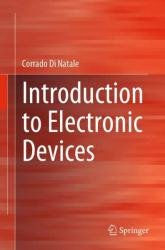 Название: Introduction to Electronic Devices
Название: Introduction to Electronic DevicesАвтор: Corrado Di Natale
Издательство: Springer
Год: 2023
Страниц: 294
Язык: английский
Формат: pdf (true), epub
Размер: 26.5 MB
This textbook offers a comprehensive introduction to the basic principles ruling the working mechanism of the most common solid-state electronic devices. It covers the physics of semiconductors and the properties of junctions of semiconductors with semiconductors, metals, and insulators. The exposition makes a minimal use of quantum mechanics concepts and methods. On the other hand, it avoids the pure phenomenological description of the properties of electronic devices. Thus, using a semi-classical approach the book provides a rigorous treatment of the subject. The book is addressed to undergraduate students of scientific and technological faculties as well to professionals who wish to be introduced to the basic principles of electronic devices.
This book stems from my teaching experience in the undergraduate courses of electronic engineering at the University of Rome Tor Vergata. The basic principles of electronic devices are presented in a simple but rigorous form, and, wherever possible, a formal explanation of device behaviors has been provided. In other cases, intuitive arguments have been introduced to provide theoretical justifications to factual observations.
The physical principles at the basis of solid-state devices are reviewed in the first chapter, where the discussion is limited to those arguments necessary for the understanding the main working mechanisms of the devices.
The presentation of the devices begins with the metal–semiconductor junction and continues with the PN junction, the bipolar junction transistors (BJT), and the field-effect transistors. The decision to start with the metal–semiconductor device may be unusual, given that this is the case where simple theory is strongly challenged by reality, not least due to the presence of surface states. On the other hand, I considered it necessary to begin the book with the junction between a semiconductor and a metal on the grounds that it is the basic ingredient for the connection of semiconductors to electric circuits.
The metal–semiconductor junction is also aimed at introducing the common properties of junctions among materials, either metals or semiconductors. Namely, junctions among materials result in space charge regions and built-in potentials, and the difference between semiconductors and metals is merely the dimension of the space charge region: large enough, in semiconductors, to influence the macroscopic properties, and small enough in metals, where, thanks to the tunnel effect, it is transparent to charge motions.
To preserve the narrative continuity, the generation and recombination phenomena, as well as the recombination function, are discussed in a separate chapter before the PN junction. For the same reason, the heterojunctions are introduced after the chapter on bipolar junction transistors, in order to promptly show their role in the improvement of the BJT characteristics. The final chapters are dedicated to the MOS, the MOSFET, and, in general, to the field-effect devices.
At the end of each chapter, a list of further readings is provided. In these reading lists, the textbooks that most inspired the author are mentioned. The suggested textbooks are nonetheless good references for those readers that want to expand their knowledge.
Besides the textbooks, at the end of each chapter, a list of journal papers is also reported. Journal papers are a sort of specialized literature hardly accessible to students. Among the papers, I privileged the historical papers, reporting the crucial discoveries and breakthroughs. The reading of these papers is suggested, so as to check the progresses and get how each discovery is related to the previous ones. Furthermore, it is an occasion to make a list of the names of those people who created the field of electronic devices, together with the procedure they implemented to achieve those results that dramatically shaped the contemporary age.
In the recent years, the interest in electronic devices has expanded to include not only solid-state physics and electronic engineering, but also other fields. The progresses in molecular electronics, particularly the interface of biomolecules with electronic devices, have increased the number of students of other disciplines interested in getting the fundamentals of electronic devices. This book, indeed, has also been written in such a way that any readers with a sufficient knowledge of basic physics, including rudiments of quantum mechanics, could find it accessible.
Contents:
Скачать Introduction to Electronic Devices
